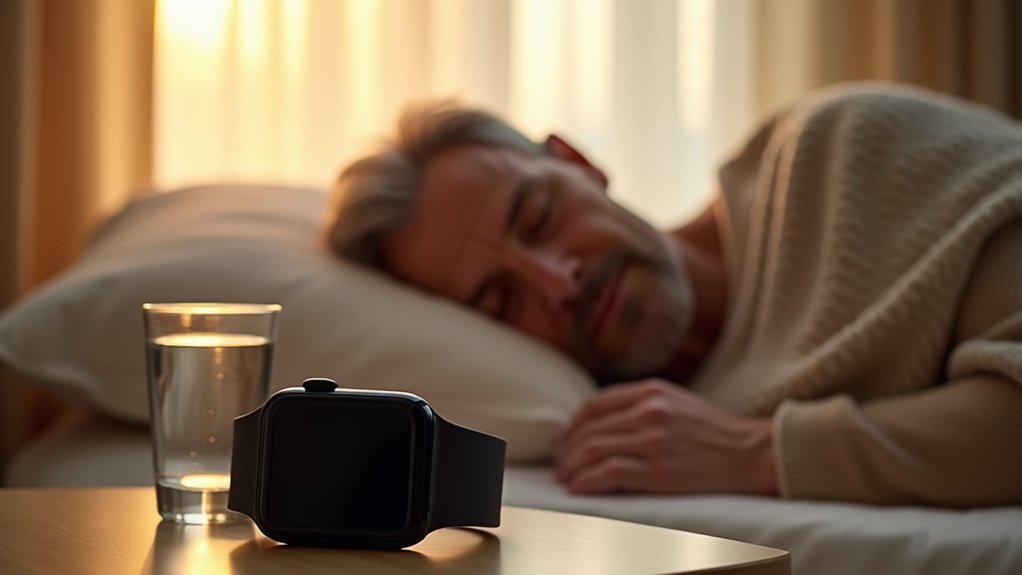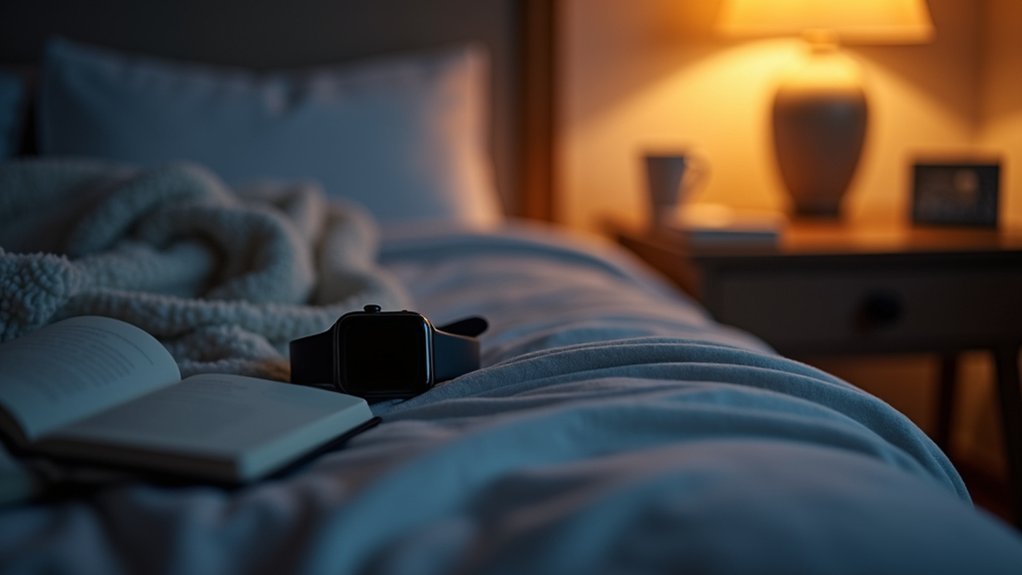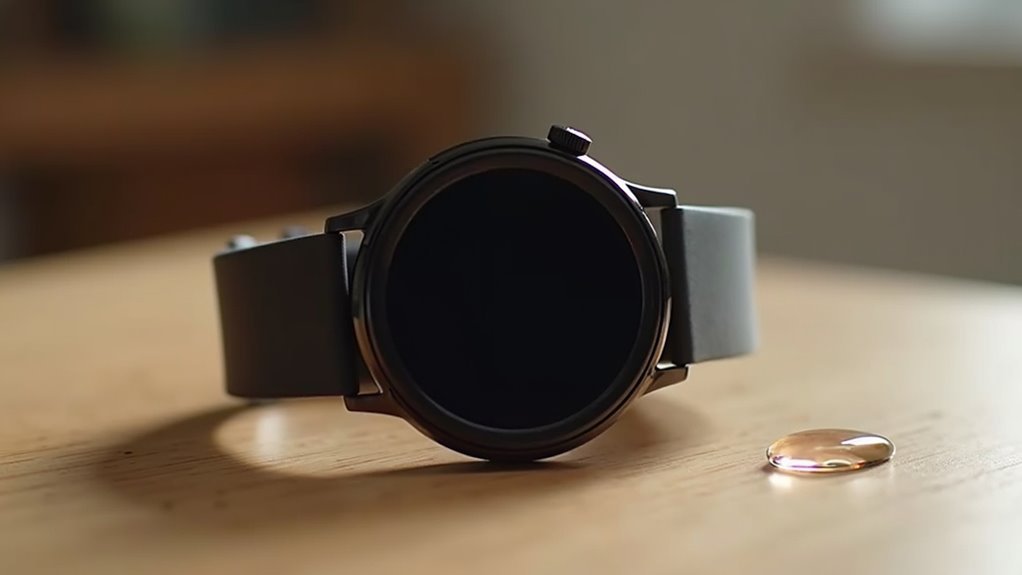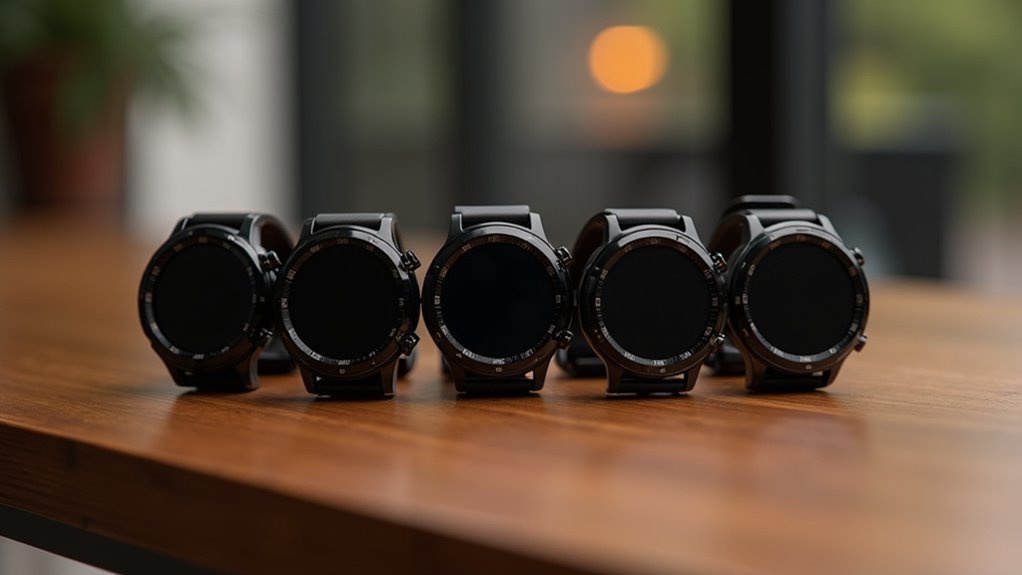Your heart rate variability changes overnight due to natural sleep stage changes that trigger autonomic nervous system shifts. During deep NREM sleep, your parasympathetic nervous system activates, increasing HRV, while REM sleep boosts sympathetic activity, reducing it. Sleep quality, disorders like apnea, stress levels, and environmental factors also influence these patterns. Your circadian rhythm creates predictable HRV fluctuations, peaking around 2 a.m. Understanding these complex interactions reveals optimization strategies.
Natural Sleep Stage Transitions and Autonomic Changes

When you fall asleep, your body undergoes the most dramatic autonomic shift of your entire daily cycle. Your heart rate variability transforms as you cycle through different sleep stages, each creating distinct autonomic profiles.
During deep NREM sleep, your parasympathetic nervous system takes control. You’ll experience increased high-frequency HRV power and longer intervals between heartbeats. Your cholinergic, noradrenergic, and serotonergic neurons reduce their activity compared to wakefulness, though your locus coeruleus shows brief increases tied to slow brain oscillations.
REM sleep flips this pattern. Your sympathetic nervous system becomes more active, reducing HF amplitude and shortening RR intervals.
These changes maintain your cardiovascular stability while adapting to changing brain states, with each stage shift carefully orchestrated by your autonomic nervous system. Sleep cycles typically last approximately 90 minutes and repeat throughout the night, creating predictable patterns of autonomic fluctuation.
Circadian Rhythm Effects on Heart Rate Variability
Beyond the sleep stage changes themselves, your heart rate variability follows a deeper rhythm that spans the entire 24-hour cycle. This circadian pattern emerges early in life and remains stable across age, even persisting through certain health conditions like early-stage diabetes.
Your parasympathetic activity peaks around 2 a.m. during slow wave sleep, maximizing HRV as part of restorative processes. Conversely, sympathetic influence dominates during daytime hours and REM sleep phases, creating lower HRV periods that coincide with vulnerable times for cardiovascular events.
These circadian HRV patterns serve as powerful indicators of your stress levels, emotional state, and sleep quality. When disrupted by shift work or jet lag, your cardiovascular and emotional well-being suffer accordingly. However, patients with cardiopulmonary conditions often display reverse dipping patterns where heart rate complexity becomes higher at night than during the day, indicating reduced adaptive capacity.
Sleep Quality and Duration Impact on HRV Patterns

While your circadian rhythms establish the foundational pattern for overnight HRV changes, the quality and duration of your actual sleep dramatically shape these variations.
Poor sleep quality consistently reduces your HRV by impairing autonomic nervous system balance and decreasing parasympathetic activity. If you take longer to fall asleep, you’ll experience elevated heart rate and diminished HRV, indicating increased physiological stress.
Sleep medications adversely affect your HRV and increase resting heart rate, disrupting normal autonomic function. Sleep fragmentation from frequent awakenings reduces parasympathetic modulation during vital NREM sleep stages.
However, sleep duration alone shows inconsistent effects on HRV in healthy adults. Sleep deprivation increases sympathetic activity and reduces HRV, while extremely short or excessively long sleep durations can both disrupt your autonomic regulation. During REM sleep, your HRV increases overall but shows reduced beat-to-beat changes as emotional states from dreams influence your autonomic nervous system.
Sleep Disorders and Their HRV Signatures
When you have sleep disorders, your HRV patterns reveal distinct signatures that can help identify specific conditions affecting your rest.
Sleep apnea creates dramatic drops in your HRV due to repeated oxygen deprivation events that spike your sympathetic nervous system activity throughout the night.
You’ll also notice fragmented sleep from frequent awakenings reduces your overall HRV by preventing your autonomic nervous system from achieving the deeper parasympathetic states essential for recovery. Research shows that short-term HRV measurements during sleep correlate more strongly with next-day vigilance problems than traditional overnight averages, making brief monitoring windows particularly valuable for detecting sleep-related impairments.
Sleep Apnea Effects
Obstructive sleep apnea creates a cascade of physiological disruptions that fundamentally alter your heart rate variability patterns throughout the night.
When your upper airway collapses during sleep, you’ll experience recurrent episodes of breathing interruption that trigger immediate cardiovascular responses. These apnea events cause sudden drops in oxygen levels and frequent awakenings, forcing your autonomic nervous system into overdrive.
Your body responds by shifting toward sympathetic dominance while reducing parasympathetic activity, creating an unhealthy sympatho-vagal imbalance.
This imbalance manifests as diminished HRV values, particularly affecting metrics like RMSSD, total power, and high-frequency components.
If you’re experiencing excessive daytime sleepiness alongside moderate-to-severe OSA, you’ll likely show even lower HRV values, indicating heightened cardiovascular risk that persists beyond sleep periods. Research reveals that sleep fragmentation specifically drives increased HRV variability, with each additional arousal per hour correlating with measurable changes in heart rate patterns.
Sleep Fragmentation Impact
Unlike complete sleep deprivation, sleep fragmentation produces surprisingly subtle effects on your heart rate variability patterns throughout the night. When you experience hourly awakenings, your HRV parameters don’t markedly deviate from baseline undisturbed sleep, unlike partial sleep restriction which clearly increases sympathetic tone and decreases vagal activity.
Each arousal triggers transient heart rate spikes and blood pressure surges, but your overall cardiac autonomic function remains surprisingly stable. While individual awakenings create brief sympathetic surges, the cumulative effect on whole-night HRV metrics like SDNN and pNN50 shows minimal change in healthy adults. Research shows that high-frequency HRV maintains strong reliability even during disrupted sleep across all major sleep stages.
However, repeated fragmentation may gradually reduce parasympathetic modulation over time, with effects varying by arousal intensity, your age, and gender-specific sleep patterns.
Stress and Emotional State Influences During Sleep

Your emotional state and stress levels don’t stop influencing your heart when you fall asleep—they continue shaping your HRV throughout the night.
Acute stress triggers immediate sympathetic nervous system activation that reduces HRV during both NREM and REM sleep stages, while chronic emotional suppression creates lasting changes in your autonomic balance. During stress, your heart rate increases and lowers HRV, reducing your body’s ability to adapt to physiological demands.
You’ll experience lower parasympathetic activity and higher sympathetic dominance, which translates to decreased sleep quality and reduced delta wave activity during deep sleep phases.
Acute Stress HRV Impact
When acute stress strikes before bedtime, it fundamentally disrupts your heart rate variability throughout the night by triggering a cascade of autonomic nervous system changes.
Your sympathetic nervous system becomes dominant, increasing heart rate while reducing HRV variability. This sympathetic overactivation decreases your heart’s adaptability to autonomic input, lowering overall HRV during sleep stages.
Simultaneously, acute stress suppresses your parasympathetic activity, measured by reductions in high frequency HRV components.
This parasympathetic withdrawal limits your heart’s ability to respond flexibly to physiological demands during sleep. Under normal conditions, your parasympathetic activity increases over successive NREM cycles, but acute stress blunts this natural progression, maintaining steadily low parasympathetic levels that correlate with poorer sleep maintenance and decreased deep sleep quality. The prolonged sympathetic activation during sleep can lead to elevated blood pressure and sustained adrenaline release that further compounds recovery difficulties.
Chronic Emotional Suppression Effects
While acute stress creates immediate disruptions to your overnight HRV, chronic emotional suppression establishes a persistent pattern of autonomic dysfunction that fundamentally alters your sleep architecture.
When you consistently suppress emotions, you’re creating sustained stress that damages your parasympathetic nervous system’s ability to self-regulate during sleep.
Your vagal HRV—crucial for emotional memory consolidation—becomes compromised, disrupting how you process emotional experiences overnight. This creates a cycle where poor emotional regulation leads to decreased HRV, which then undermines sleep quality and cognitive function.
Suppressing emotions increases cognitive arousal, preventing your autonomic nervous system from achieving the balance necessary for restorative sleep. Research shows that higher vagal activity during sleep correlates with improved memory for neutral stimuli, while reduced vagal activity creates an imbalanced focus on emotional content.
Lower HRV becomes a biomarker of this dysfunction, indicating your vulnerability to stress-related sleep disturbances and depressive symptoms.
Exercise Recovery and Training Load Effects
Exercise considerably influences your overnight heart rate variability, with the type, intensity, and timing of physical activity creating distinct patterns in your autonomic nervous system recovery.
High-intensity workouts initially suppress HRV through sympathetic dominance, but trigger a parasympathetic rebound during sleep that can enhance recovery markers.
Your training load accumulation matters greatly. While chronic high-intensity training can strain your autonomic system and temporarily lower HRV, consistent exercise ultimately improves your parasympathetic function through metabolic adaptations and increased nitric oxide availability.
Resistance training particularly benefits overnight HRV by reducing sympathetic tone. Your HRV naturally decreases with age, which means older athletes may see different overnight recovery patterns compared to younger individuals.
Recovery strategies you employ affect these patterns. Diaphragmatic breathing, adequate sleep, and stress management techniques enhance your parasympathetic activity during overnight recovery periods, maximizing the restorative benefits reflected in improved HRV measurements.
Lifestyle Factors That Alter Overnight HRV

Beyond exercise and training, your daily lifestyle choices create powerful ripple effects that extend into your overnight heart rate variability patterns.
Stress, anxiety, and depression trigger sympathetic nervous system dominance during sleep, reducing your HRV through sustained autonomic imbalance. Night shift work disrupts your circadian rhythm, while environmental noise activates stress responses that persist overnight.
Your consumption habits greatly impact autonomic regulation. Alcohol beyond moderate limits impairs parasympathetic activity, with metabolic processing creating sympathetic activation during sleep.
Late-day caffeine stimulates your nervous system well into nighttime hours, though timing matters more than quantity. Smoking decreases parasympathetic tone throughout sleep periods.
Heavy meals rich in saturated fats or high-glycemic carbohydrates lower overnight HRV, while omega-3 fatty acids and probiotics support better autonomic balance. Body weight also influences HRV patterns, as excess weight can reduce overall heart rate variability during rest periods.
Environmental Conditions and Sleep Environment
Your bedroom becomes a silent conductor orchestrating your autonomic nervous system throughout the night, with every environmental detail influencing your heart rate variability patterns.
Temperature extremes disrupt your sleep stages, while evening light exposure suppresses melatonin production and reduces parasympathetic activity. Noise pollution triggers sympathetic responses that lower your HRV during vital recovery periods.
Three key environmental factors directly impact your overnight HRV:
- Temperature control – Maintain 65-68°F for ideal sleep quality and autonomic balance.
- Light management – Use blackout curtains and avoid screens before bed to support melatonin production.
- Air quality optimization – Guarantee proper ventilation and humidity levels between 30-50%.
Your sleep schedule consistency matters equally. Irregular bedtimes disrupt circadian rhythms, while your sleeping position affects breathing patterns that influence heart rate variability throughout different sleep stages. Non-REM sleep typically shows elevated heart rate variability compared to REM phases, demonstrating how sleep architecture directly affects autonomic nervous system activity.
Age, Sex, and Individual Physiological Differences

While environmental factors set the stage for ideal heart rate variability, your biological blueprint plays an equally powerful role in determining how your HRV changes throughout the night.
Your age notably impacts these patterns—HRV peaks around 15, then progressively declines as deep sleep stages diminish with aging. This reduction blunts the parasympathetic activity that typically boosts nighttime HRV.
HRV peaks in teenage years around 15, then steadily decreases with age as deep sleep quality diminishes and parasympathetic activity weakens.
Your sex also matters considerably. If you’re a woman under 50, you’ll likely show lower but more stable HRV during sleep compared to men.
However, this reverses after 50, with older women displaying higher values than their male counterparts.
Your individual physiology—including baseline heart rate, sleep architecture quality, autonomic sensitivity, genetics, and fitness level—creates unique overnight HRV fingerprints that distinguish your patterns from others. Research on large populations shows that HRV patterns can be influenced by weekly variations, with values typically peaking on weekends and reaching their lowest points mid-week.
Cardiovascular Health Status and HRV Changes
Cardiovascular health creates perhaps the most dramatic influence on your overnight HRV patterns, often overriding the subtle effects of age and sex.
When you have cardiovascular disease like hypertension or heart arrhythmia, you’ll typically experience reduced HRV that reflects autonomic nervous system dysfunction. Your heart loses its ability to adapt to stress and environmental changes, reducing the dynamic variability that signals healthy cardiovascular function.
Three key cardiovascular factors affecting your overnight HRV include:
- Autonomic balance disruption – Impaired vagal tone and increased sympathetic dominance
- Stress recovery capacity – Reduced ability to recover from daily physiological demands during sleep
- Sleep-related cardiovascular function – Disrupted autonomic modulation correlating with hypertension risk
Your overnight HRV serves as an early indicator for cardiovascular risk and future adverse health events. The hypothalamus processes these autonomic signals throughout the night, integrating information from both sympathetic and parasympathetic branches to maintain cardiovascular stability during sleep cycles.
Wearable Device Accuracy and Measurement Considerations
When you’re monitoring overnight HRV changes, where you place your wearable device greatly affects measurement accuracy and reliability.
Your device’s sampling rate creates inherent limitations in capturing the precise beat-to-beat variations that ECG systems can detect.
WHOOP demonstrates superior accuracy with a standard deviation of just 3.9 ms for HRV measurements, while other wearables range from 28.1 to 46.9 ms.
You’ll need to understand these technical constraints to properly interpret your overnight HRV data and distinguish between actual physiological changes and measurement artifacts.
Device Placement Impact
Since the accuracy of overnight heart rate variability measurements depends heavily on where you place your wearable device, understanding placement’s impact becomes essential for reliable data collection.
Your device’s location affects signal quality and measurement consistency throughout the night.
Different placement sites create varying levels of accuracy:
- Chest-strap devices provide the highest precision due to their proximity to your heart and minimal motion artifacts during sleep.
- Wrist-worn devices often struggle with accuracy because they rely on optical sensors affected by skin thickness, movement, and ambient light interference.
- Areas with better blood flow and less muscle movement capture more stable signals, improving your overnight HRV data reliability.
Body movements during sleep can displace wrist devices, causing signal loss or contamination in your HRV measurements.
The wearable market continues expanding rapidly, with projections showing it will become a $27 billion industry by 2022 as millions seek personal health monitoring solutions.
Sampling Rate Limitations
Beyond device placement, the sampling rate of your wearable device fundamentally determines how accurately it can capture heart rate variability measurements throughout the night. Your device’s sampling frequency directly affects which HRV components it can detect, particularly high-frequency variations that reflect parasympathetic nervous system activity during sleep.
| Sampling Rate | Time-Domain Accuracy | Frequency-Domain Accuracy |
|---|---|---|
| 100 Hz | Adequate | Poor |
| 125 Hz | Good | Limited |
| 250 Hz | Excellent | Good |
| 500 Hz | Excellent | Excellent |
| 1000 Hz | Excellent | Excellent |
Lower sampling rates compromise your device’s ability to capture short-term HRV fluctuations essential for overnight assessments. While manufacturers choose reduced rates to preserve battery life, this trade-off means you’ll get reliable basic metrics but potentially miss detailed frequency-domain analysis that reveals deeper insights into your autonomic nervous system’s nighttime behavior. For meaningful overnight HRV assessment, recordings should span at least 20 minutes to ensure statistical accuracy of the measurements.
Frequently Asked Questions
Can Certain Medications Affect My Overnight Heart Rate Variability Readings?
Yes, certain medications can affect your overnight HRV readings. Beta-blockers, sedatives, benzodiazepines, tricyclic antidepressants, and analgesics modify autonomic nervous system regulation, typically reducing your heart rate variability during sleep through various mechanisms.
Do Seasonal Changes or Weather Patterns Influence Overnight HRV Measurements?
Your overnight HRV readings fluctuate seasonally, with higher values in summer and lower in winter. Weather patterns like rainfall and humidity positively affect HRV, while extreme temperatures can reduce it.
How Quickly Do Overnight HRV Patterns Return to Normal After Illness?
Your overnight HRV patterns typically start recovering within days after mild illness, but you’ll need weeks to months for full normalization following severe conditions like heart attacks, depending on your sleep quality and stress management.
Can Dietary Supplements or Vitamins Improve My Overnight Heart Rate Variability?
You can improve your overnight HRV with omega-3s, magnesium, and B vitamins, especially if you’re deficient. These supplements work best when you’re addressing nutritional gaps rather than expecting dramatic changes.
Do Menstrual Cycles Affect Women’s Overnight HRV Patterns Throughout the Month?
Yes, your menstrual cycle greatly affects overnight HRV patterns. You’ll experience higher HRV during your follicular phase and lower HRV during your luteal phase due to progesterone’s impact on your autonomic nervous system.
In Summary
Your overnight HRV changes stem from multiple interconnected factors you can’t always control. Your body’s natural sleep cycles, circadian rhythms, and autonomic nervous system create predictable fluctuations, while your stress levels, sleep quality, and environment add variability. Your age, sex, and cardiovascular health also influence these patterns. You’ll notice that sleep disorders can disrupt normal HRV signatures, and even your wearable device’s accuracy affects what you’re seeing.





Leave a Reply